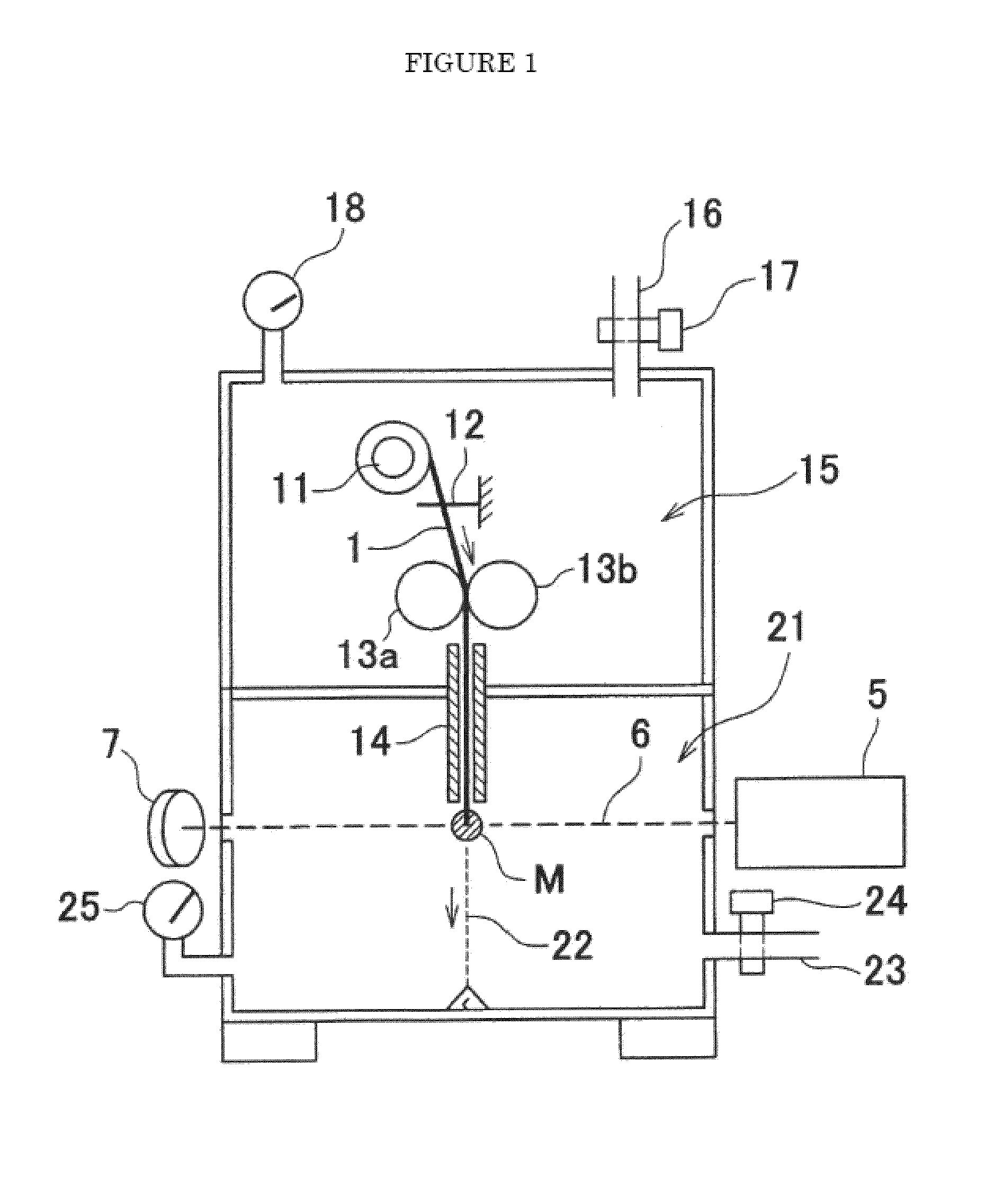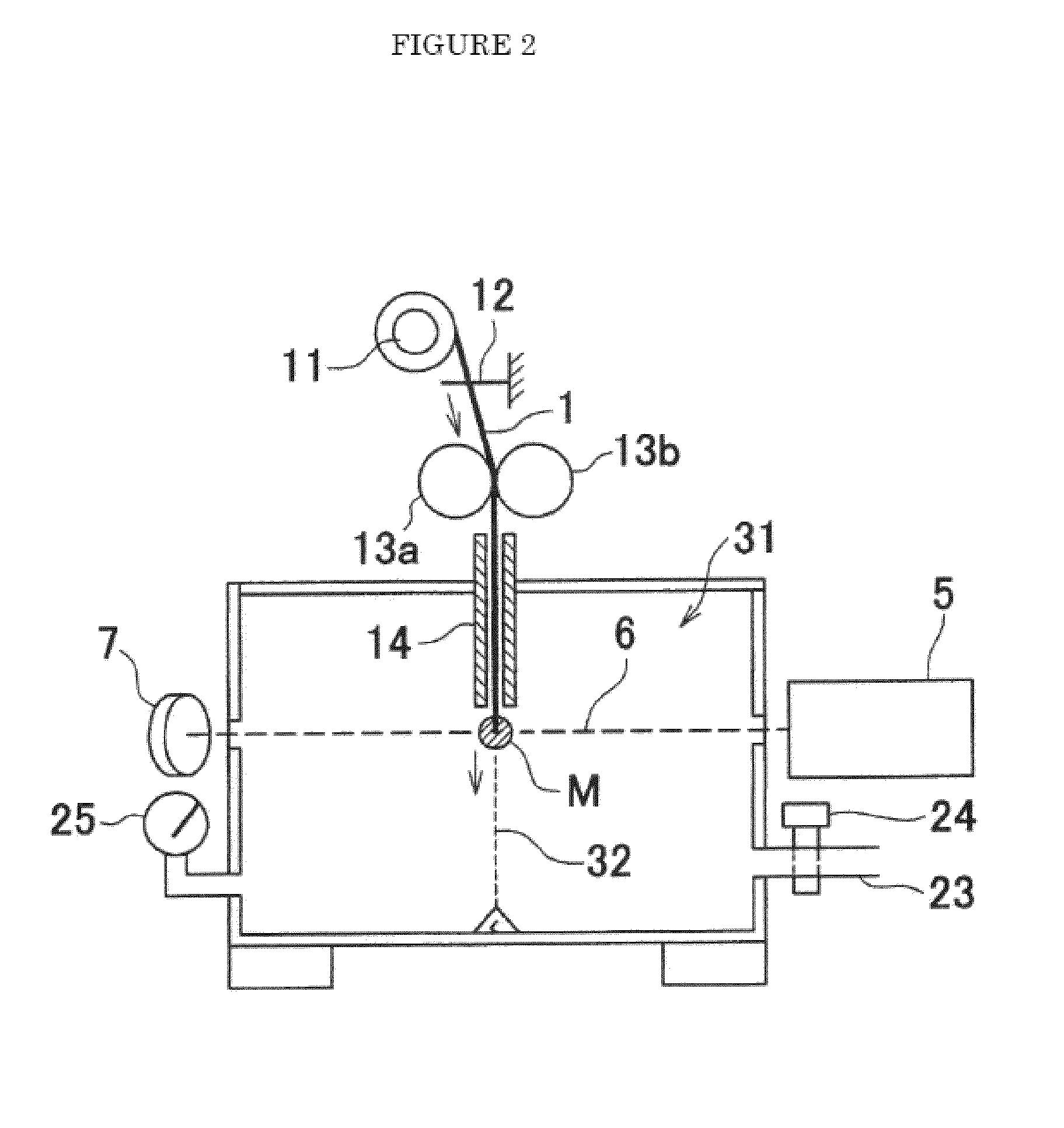Production method and production device of ultrafine filament
a production method and ultrafine filament technology, applied in the direction of filament/thread forming, electric/magnetic/electromagnetic heating, fibre treatment, etc., can solve the problems of complex manufacturing method, small resin particles, and lack of molecular orientation in the filament obtained, so as to improve molecular orientation and high manufacturing cost , the effect of high precision
- Summary
- Abstract
- Description
- Claims
- Application Information
AI Technical Summary
Benefits of technology
Problems solved by technology
Method used
Image
Examples
example 1
[0066]An undrawn poly(ethylene terephthalate) (PET) filament (filament diameter 182 μm) was used and was drawn using the drawing apparatus shown in FIG. 2. The laser the emitter used at this point was a carbon dioxide laser emitter with laser output of 8 W, and the beam diameter (light beam) was 2.0 mm. The type of orifice shown in FIG. 5a was used as the orifice, and the orifice diameter D2 was 0.5 mm. The degree of vacuum in the drawing chamber was adjusted to 8 KPa. The supply speed of the original filament was changed from 0.1 m / min to 0.2 m / min, 0.3 m / min and 0.4 m / min, and the filament diameters of the filaments obtained are shown in Table 2. In addition, the filament diameters when the laser output was changed from two watts to eight watts are also shown. According to the data in the table, a nanofiber with an average filament diameter of 0.313 μm (313 nanometers) was obtained when using eight watts of laser power and a supply speed of 0.1 m / min. The standard deviation for th...
example 2
[0067]The same undrawn poly(ethylene terephthalate) filament used in Example 1 was used as the original filament. The same drawing chamber and laser emitter used in Example 1 were used. The experiment was conducted using a filament supply speed of 0.1 m / min at different degrees of vacuum for the drawing chamber. When the degree of vacuum was 8 KPa, the average filament diameter was 0.31 μm as shown in Example 1. When the degree of vacuum was 6 KPa, the average filament diameter was 0.42 μm. When the degree of vacuum was 24 KPa, The average filament diameter was 0.82 μm. Filaments with filament diameters less than 1 μm were obtained even under these conditions.
example 3
[0068]An undrawn poly(lactic acid) (PLLA) filament (filament diameter 75 μm) was used as the original filament and was drawn using the drawing apparatus of FIG. 2. A carbon dioxide gas laser emitter with a laser output of eight watts was used for this case, and the beam diameter (light beam) was 2.0 mm. The type of orifice described in FIG. 5(a) was used as the orifice, and the orifice diameter d2 was 0.5 mm. The degree of vacuum in the drawing chamber was adjusted to 8 kPa. The original filament supply speed was changed from 0.1 m / min to 0.8 m / min, and the filament diameters of the filaments obtained are shown in Table 4. In addition, the filament diameters when the laser output was changed from two watts to eight watts are also shown in the table. According to the data in the table, a nanofiber with an average filament diameter of 0.13 μm (130 nanometer) was obtained when the laser power was eight watts (watt density 256.6 W / cm2) and the supply speed was 0.1 m / min. The filament di...
PUM
| Property | Measurement | Unit |
|---|---|---|
| diameter | aaaaa | aaaaa |
| pressure | aaaaa | aaaaa |
| air speed | aaaaa | aaaaa |
Abstract
Description
Claims
Application Information
 Login to View More
Login to View More - R&D
- Intellectual Property
- Life Sciences
- Materials
- Tech Scout
- Unparalleled Data Quality
- Higher Quality Content
- 60% Fewer Hallucinations
Browse by: Latest US Patents, China's latest patents, Technical Efficacy Thesaurus, Application Domain, Technology Topic, Popular Technical Reports.
© 2025 PatSnap. All rights reserved.Legal|Privacy policy|Modern Slavery Act Transparency Statement|Sitemap|About US| Contact US: help@patsnap.com



